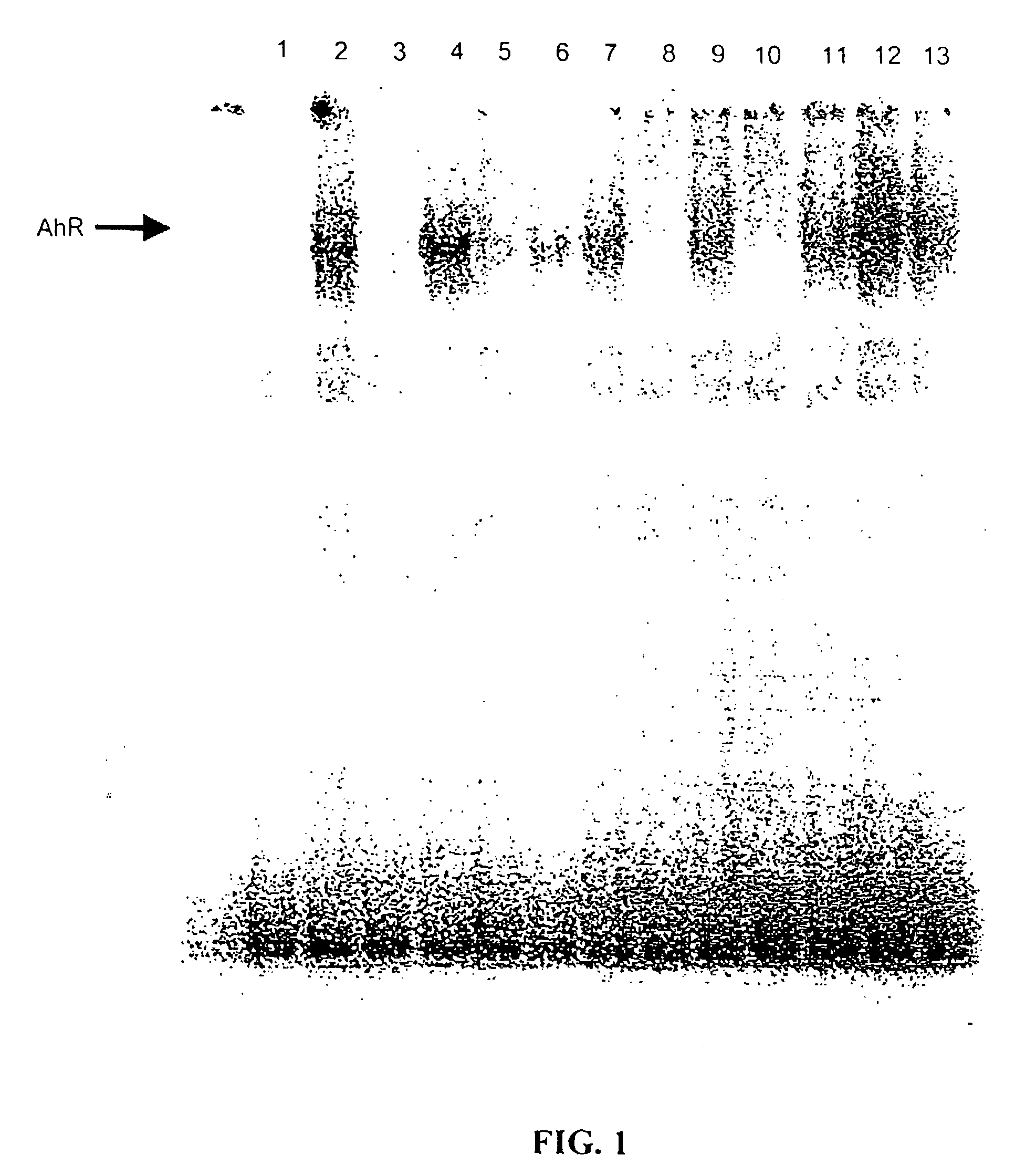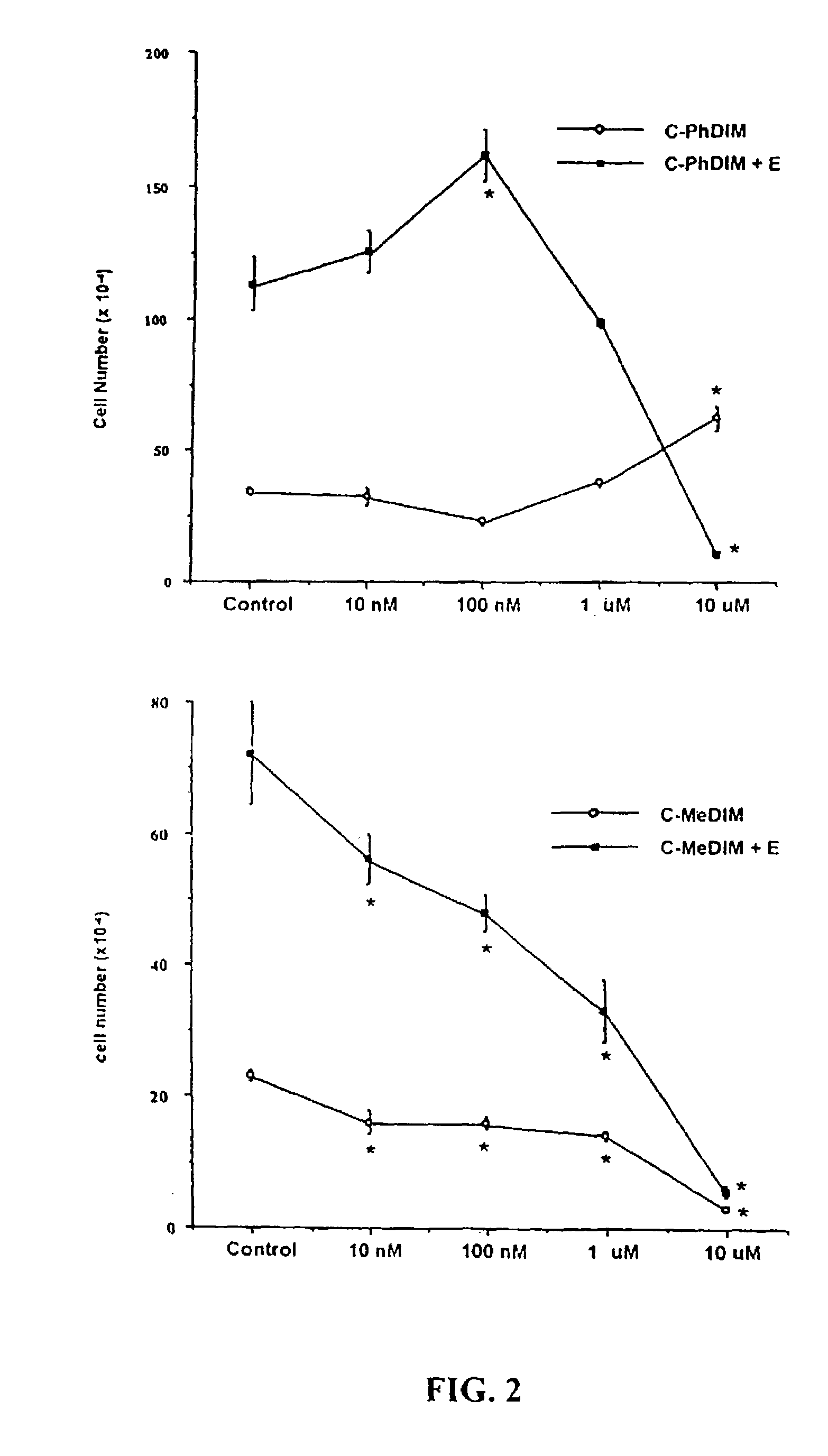Compositions containing C-substituted diindolylmethane compounds
a technology of diindolylmethane and compound, which is applied in the field of compositions containing diindolylmethane, can solve the problems of ineffective cancer treatment, large negative side effects, and inability to confer appreciable benefits of vegetable and fruit cancer, and achieves potent antiestrogenic/antitumorigenic activity, inhibiting mammary and endometrial cancer cell proliferation, and inhibiting tumor growth
- Summary
- Abstract
- Description
- Claims
- Application Information
AI Technical Summary
Benefits of technology
Problems solved by technology
Method used
Image
Examples
example 1
Synthesis of Diindolylmethane
[0058]Indole or ring-substituted indoles (e.g., 5-methoxy, 5-chloro, 5-bromo, 5-fluoro, 5-methyl, 5-nitro, N-methyl and 2-methyl) are commercially available and these compounds are used for synthesis of diindolylmethane analogs. Alkyl, substituted alkyl, aromatic, or substituted aromatic aldehydes (0.01 mole) are incubated with indole or a substituted indole (0.02 mole) in water (50 ml) plus glacial acetic acid (0.5 ml). Depending on the structure of the aldehyde or indole, the reaction is continued with stirring for 2 days to 2 weeks. The reaction product is either filtered or isolated by extraction with chloroform and the residue crystallized from benzene / petroleum spirit. The resulting substituted DIM is then used in in vivo or in vitro studies. DIMs tend to be photosensitive and should be stored in dark brown vials.
example 2
Diindolylmethane Analogs as Antitumorigenic Agents for the Treatment of Multiple Cancers
[0059]Initial studies used TCCSUP and J82 human bladder cancer cell lines that were maintained in RPMI culture media supplemented with 10% fetal bovine serum. Cell proliferation studies were carried out in multi-well plates, and compounds (in DMSO, 0.1% vol. / vol.) were added and cell growth was determined over a period of 4–10 days. The growth inhibitory properties of DIM and related analogs were determined using the following prototypical compounds: DIM, 5,5′-dimethylDIM (5-Me-DIM), 2,2′-dimethylDIM (2-Me-DIM), and 5,5′-dichloroDIM (5-Cl-DIM) at concentrations from 0.1–10 μM. Proliferation of both human bladder cancer cell lines was significantly inhibited by all compounds used in this study; moreover, the more sensitive TCCSUP cells were inhibited by all compounds at the lowest concentration (0.1 μM) (FIG. 1). Interestingly, the DIM analogs were >100 times more inhibitory than genistein and rel...
example 3
PPAR(Activity of DIM Analogs
[0061]Peroxisome proliferator-activated receptor (PPAR) is a nuclear receptor that induces differentiation in multiple tissues and cell lines. Synthetic compounds that bind PPAR (inhibit growth, induce differentiation in multiple tumor cell lines, and inhibit mammary carcinogenesis in rodent models (Mueller et al., “Terminal differentiation of human breast cancer through PPAR”Mol. Cell 1:465–470, 1998; Elstner et al., “Ligands for peroxisome proliferator-activated receptor gamma and retinoic acid receptor inhibit growth and induce apoptosis of human breast cancer cells in vitro and in BNX mice”Proc. Natl. Acad. Sci. USA 95:8806–8811, 1998; Brockman et al., “Activation of PpaRg leads to inhibition of anchorage independent growth of human colorectal cancer cells”Gastroenterology 115:2049–1055, 1998; Tontonoz et al., “Terminal differentiation of human lipsarcoma cells induced by ligands for peroxisome proliferator-activated receptor and the retinoid X recept...
PUM
 Login to View More
Login to View More Abstract
Description
Claims
Application Information
 Login to View More
Login to View More - R&D
- Intellectual Property
- Life Sciences
- Materials
- Tech Scout
- Unparalleled Data Quality
- Higher Quality Content
- 60% Fewer Hallucinations
Browse by: Latest US Patents, China's latest patents, Technical Efficacy Thesaurus, Application Domain, Technology Topic, Popular Technical Reports.
© 2025 PatSnap. All rights reserved.Legal|Privacy policy|Modern Slavery Act Transparency Statement|Sitemap|About US| Contact US: help@patsnap.com



